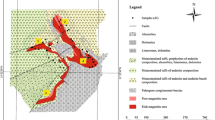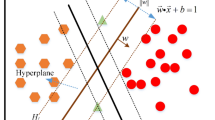Abstract
One of the most important steps in the mineral resource estimation and detailed exploration of porphyry copper deposit is separating the alteration zones as a control parameter of the copper grade. The most popular method for this separation is petrological investigations (other methods are not much popular), but the method lacks the ability to predict alteration zones of the un-sampled points. In this paper a new method has been proposed which is based on the support vector machine (SVM) classification of the analyzed whole rock samples and it has been used in Sungun porphyry copper deposit to separate potassic, phyllic and transition alteration zones. To apply the SVM method, use has been made of the radial basis function (RBF) as the kernel function and to obtain the optimal values for the SVM parameters (γ and C being the most important); the grid search method has been used. The best values for γ and C that have had good performance in the training and test steps are 0.0625 and 32, respectively. Results have revealed that the SVM classification (used in this study) can effectively separate the alteration zones in the Sungun deposit. Specifically, the accuracy of this method has been 75% which proves that the support vector machine can offer an inexpensive, fast and robust classification technique and it can be a valid alternative to the well established methodologies in this area.
Similar content being viewed by others
References
Abedi, M., Norouzi, G.H. and Bahroudi, A. (2012) Support vector machine for multi-classification of mineral prospectivity areas. Computers & Geosciences, v.46, pp.272–283.
Asghari, O., Hezarkhani, A. and Rafiee, V. (2008) Applying discriminat amalysis and SGS to separating alteration zones within the Sungun porphyry copper deposit. Paper presented at the 8th International Scientific Conference- SGEM2008.
Berger, B.R., Ayuso, R.A., Wynn, J.C. and Seal, R.R. (2008). Preliminary model of porphyry copper deposits: U.S. Geological Survey Open-File Report 2008–1321, 55p.
Calagari, A. A. (2003) Stable isotope (S, O, H and C) studies of the phyllic and potassic–phyllic alteration zones of the porphyry copper deposit at Sungun, East Azarbaidjan, Iran. Jour. Asian Earth Sci., v.21, pp.767–780.
Calagari, A. A. (2004). Fluid inclusion studies in quartz veinlets in the porphyry copper deposit at Sungun, East-Azarbaidjan, Iran. Jour. Asian Earth Sci., v.23, pp.179–189.
Camps-Valls, G. and Bruzzone, L. (2005) Kernel-based methods for hyperspectral image classification. IEEE Transactions on Geoscience and Remote Sensing, v.43(6), pp.1351–1362.
Camps-Valls, G. and Bruzzone, L. (2009) Kernel methods for Remote Sensing Data Analysis. Wiley & Sons, UK.
Camps-Valls, G., GóMez-Chova, L., MuÑOz-MarÍ, J., VilafrancÉS, J. and Calpe-Maravilla, J. (2006) Composite kernels for hyperspectral image classification. IEEE Geoscience and Remote Sensing Lett., v.3(1), pp.93–97.
Chang, C.C. and Lin, C.J. (2011) LIBSVM: a library for support vector machines. ACM Trans. Intelligent Systems and Technology, v.2, pp.27:1–27:27.
Cooke, D., Hollings, P. and Walsh, J. (2005). Giant porphyry deposits: characteristics, distribution, and tectonic controls. Econ. Geol., v.100, pp.801–818.
Elliott, J.E., Wallace, C.A., Lee, G.K., Antweiler, J.C., Lidke, D.J., Rowan, L.C., et al. (1992) Maps showing mineral resource assessment for skarn deposits of gold, silver, copper, tungsten, and iron in the Butte 1° x 2° Quadrangle, Montana: USGS Misc Investigations Series, I-2050-E.
Fattahi, H., Ebrahimi Farsangi, M. A., Shojaee, S., Nekooei, K. and Mansouri, H. (2013) Application of the Hybrid Harmony Search with Support Vector Machine for Identification and Classification of Damaged Zone around Underground Spaces. Internat. Jour. Optimization in Civil Engg., v.3(2), pp.345–358.
Hall, M., Frank, E., Holmes, G., Pfahringer, B., Reutemann, P. and Witten, I.H. (2009) The WEKA Data Mining Software: An Update; SIGKDD Explorations, Volume 11, Issue 1.
Hezarkhani, A. (1997) Physicochemical controls on alteration and copper mineralization in the Sungun porphyry copper system, Iran. University of McGill, Montreal, Quebec, Canada.
Hezarkhani, A. (2002) Specific Physico-Chemical Conditions (360 °C) for Chalcopyrite Dissolution/Porphyry system in the Reagan Porphyry Copper Porphyry system, Iran. Amirkabir Jour. Sci. Tech., v.13(52), pp.668–687.
Hezarkhani, A. (2003) Hydrothermal evolution in the Raigan porphyry copper system based on fluid inclusion studies, (Kerman, Iran): the path to an uneconomic deposit. Amirkabir Jour. Sci. Tech., v.15, pp.74–84.
Hezarkhani, A. (2006) Petrology of the intrusive rocks within the Sungun Porphyry Copper Deposit, Azerbaijan, Iran. Jour. Asian Earth Sci., v.27, pp.326–340.
Hezarkhani, A. and Williams-Jones, A.E. (1998) Controls of alteration and mineralization in the Sungun Porphyry Copper Deposit, Iran: evidence from fluid inclusions and stable isotopes. Econ. Geol., v.93, pp.651–670.
Hezarkhani, A., Williams-Jones, A.E. and Gammons, C.H. (1999) Factors controlling copper solubility and chalcopyrite dissolution in the Sungun porphyry copper deposit, Iran. Mineralium Deposita, v.34, pp.770–783.
Hsu, C.W., Chang, C.C. and Lin, C.J. (2010) A Practical Guide to Support Vector Classification, Technical Report (pp.1–12): Department of Computer Science and Information Engineering, University of National Taiwan, Taipei.
Hsu, C.W. and Lin, C.J. (2002) A comparison of methods for multiclass support vector machines. IEEE Trans. Neural Networks, v.13(2), pp.415–425.
Huang, C.-L. and Wang, C.-J. (2006) A GA-based feature selection and parameters optimization for support vector machines. Expert Systems with Applications, v.31, pp.231–240.
John, D. A., Ayuso, R. A., Barton, M. D., Blakely, R. J., Bodnar, R. J., Dilles, J. H., et al. (2010) Porphyry copper deposit model, chap. B of Mineral deposit models for resource assessment: USGS Scientific Investigations Report 2010–5070–B. 169.
Li, J.-W., Zhao, X.-F., Zhou, M.-F., Vasconcelos, P., Ma, C.-Q., Deng, X.-D., et al. (2008) Origin of the Tongshankou porphyry–skarn Cu–Mo deposit, eastern Yangtze craton, Eastern China: geochronological, geochemical, and Sr–Nd–Hf isotopic constraints. Mineralium Deposita, v.43(3), pp.315–336.
Luts, J., Ojeda, F., Plas, R. V. D., Moor, B. D., Huffel, S. V. and Suykens, J. A. K. (2010) A tutorial on support vector machinebased methods for classification problems in chemometrics. Analytica Chimica Acta, v.665, pp.129–145.
Mehrpartou, M. (1993) Contributions to the geology, geochemistry, ore genesis and fluid inclusion investigations on Sungun Cu-Mo porphyry deposit, (Northwest of Iran).
Milgram, J., Cheriet, M. and Sabourin, R. (2006) One Against One” or “One Against All”: Which One is Better for Handwriting Recognition with SVMs?” 10th Internat. Workshop on Frontiers in Handwriting Recognition, pp.10–23.
Mitchell, T.M. (1997) Machine Learning. McGraw Hill, New York, 414p.
Mountrakis, G., Im, J. and Ogole, C. (2011) Support vector machines in remote sensing: A review. ISPRS Jour. Photogrammetry and Remote Sensing, v.66(3), pp.247–259.
Perez, C. A., Estevez, P. A., Vera, P. A., Castillo, L. E., Aravena, C. M., Schulz, D. A., et al. (2011) Ore grade estimation by feature selection and voting using boundary detection in digital image analysis. Internat. Jour. Mineral Processing, v.101, pp.28–36.
Petropoulos, G.P., Kalaitzidis, C. and Vadrevu, K.P. (2012) Support vector machines and object-based classification for obtaining land-use/cover cartography from Hyperion hyperspectral imagery. Computers & Geosci., v.41, pp.99–107.
Ratnanjali, S. and Satish, K. (2008) The Effect of Kernal Function on Classification. Paper presented at the XXXII National Systems Confernece, NSC-2008, December, 17–19.
Richards, J. P. (2003) Tectono-Magmatic Precursors for Porphyry Cu-(Mo-Au) Deposit Formation. Econ. Geol., v.98, pp.1515–1533.
Salahshoor, K., Kordestani, M. and Khoshro, M.S. (2010). Fault detection and diagnosis of an industrial steam turbine using fusion of SVM (support vector machine) and ANFIS (adaptive neuro-fuzzy inference system) classifiers. Energy, v.35, pp.5472–5482.
Seng, D. and Chen, W. (2009). Application of RS Theory and SVM in the Ore-Rock Classification. Paper presented at the Computational Intelligence and Software Engineering, 2009. CiSE 2009. International Conference on.
Shahabpour, J. (1994). Post-mineralization breccia dike from the Sar-Cheshmeh porphyry copper deposit, Kerman, Iran. Explor. Mining Geol., v.3, pp.39–43.
Shawe-Taylor, J. and Sun, S. (2011) A review of optimization methodologies in support vector machines. Neurocomputing, 74, 3609–3618.
Shin, K.-S., Lee, T.S. and Kim, H.-j. (2005) An application of support vector machines in bankruptcy prediction model. Expert Systems with Applications, v.28, pp.127–135.
Sillitoe, R. H. (1973) The Tops and Bottoms of Porphyry Copper Deposits. Econ. Geol., v.68, pp.799–815.
Simin, C., Rongqun, Z., Liming, L. and De, Z. (2010) A method of salt-affected soil information extraction based on a support vector machine with texture features. Mathematical and Computer Modelling, v.51, pp.1319–1325.
Taboada, J., MatÍAs, J. M., AraÚJo, M. and OrdÓÑEz, C. (2006) Assessing the viability of underground slate mining by combining an expert system with a GIS. Engg. Geol., v.87, pp.75–84.
Thabtah, F.A. and Cowling, P.I. (2007) A greedy classification algorithm based on association rule. Applied Soft Computing, v.7, pp.1102–1111.
Titley, S. and Beane, R. (1981) Porphyry copper deposits. Part 1. Geologic settings, petrology, and tectogenesis. Econ. Geol., v.75, pp.214–235.
Yao, X., Tham, L.G. and Dai, F.C. (2008) Landslide susceptibility mapping based on Support Vector Machine: A case study on natural slopes of Hong Kong, China. Geomorphology, v.101, pp.572–582.
Zuo, R. and M.Carranza, E. J. (2011) Support vector machine: A tool for mapping mineral prospectivity. Computers & Geosciences, v.37, pp.1967–1975.
Author information
Authors and Affiliations
Corresponding author
Rights and permissions
About this article
Cite this article
Abbaszadeh, M., Hezarkhani, A. & Soltani-Mohammadi, S. Classification of alteration zones based on whole-rock geochemical data using support vector machine. J Geol Soc India 85, 500–508 (2015). https://doi.org/10.1007/s12594-015-0242-3
Received:
Accepted:
Published:
Issue Date:
DOI: https://doi.org/10.1007/s12594-015-0242-3




